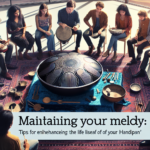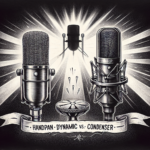PANArt, short for Panglobal Art, is more than just a musical instrument manufacturer. Founded in 1993 in Bern, Switzerland, by Felix Rohner and Sabina Schärer, PANArt has been pioneering the development of unique musical instruments that have captivated the hearts of musicians and listeners worldwide. Through their innovative creation, the Hang, PANArt has successfully bridged cultures and introduced a new dimension of sound that transcends traditional musical boundaries.
The Genesis of the Hang
In the late 1990s, Felix Rohner and Sabina Schärer were experimenting with steelpan technology. Their curiosity and passion for creating something unique led to the invention of the Hang. Derived from the Trinidadian steelpan, the Hang (pronounced “hung”) is an idiophone – a class of musical instrument that produces sound through the vibration of its material.
The word “Hang” itself comes from the Bernese German word for “hand,” reflecting the instrument’s design to be played with the hands as opposed to mallets or sticks. The Hang consists of two deep-drawn, nitrided steel hemispheres glued together at the rim, creating a hollow, resonant body. The upper side, known as the “Ding” side, features a central dome surrounded by seven to eight tone fields tuned to specific pitches. The bottom side, or “Gu” side, has a single opening called the “Gu hole,” which functions as a Helmholtz resonator.
Innovative Soundscapes
One of the most remarkable aspects of the Hang is its ability to produce a rich tapestry of sound. The instrument offers a blend of sweetness and percussiveness that can evoke a wide range of emotions and atmospheres. The hypnotic sound of the Hang is achieved through precise tuning and the unique physical properties of the instrument’s material.
Players can generate different pitches, overtones, and harmonics by striking various points on the tone fields with their hands and fingers. The subtle touches, gentle taps, and more assertive strikes allow for a highly expressive and dynamic performance. This characteristic sound has made the Hang a favorite among musicians, street performers, and meditation practitioners who seek a serene and captivating auditory experience.
Cultural Bridging
One of the most significant impacts of PANArt’s Hang is its ability to bridge cultures. Unlike many traditional instruments, the Hang does not belong to any single cultural or historical context. Instead, it embodies a global fusion of influences, reflecting the contemporary era of cross-cultural exchange.
The Hang has brought together musicians from diverse backgrounds, encouraging collaborations that transcend geographical and cultural boundaries. From African drumming traditions to Indian classical music, and from Western classical compositions to contemporary electronic music, the Hang has found its place in a myriad of musical genres. This versatility has allowed the instrument to act as a unifying force, fostering mutual understanding and appreciation among different cultural communities.
Artistic and Therapeutic Potential
Beyond its cultural significance, the Hang also possesses remarkable artistic and therapeutic potential. Many musicians and sound therapists have discovered the instrument’s ability to induce relaxation, reduce stress, and facilitate meditation. The soothing and resonant tones of the Hang create a meditative atmosphere that allows listeners to enter a state of deep relaxation and introspection.
Artists have also found inspiration in the Hang’s unique sound palette. Its ethereal and otherworldly tones have been incorporated into film scores, ambient music, and experimental compositions. The Hang’s versatility and capacity to evoke profound emotional responses have made it a valuable tool for creative expression and exploration.
The Legacy Continues
As PANArt continues to innovate and push the boundaries of musical instrument design, the legacy of the Hang lives on. In recent years, Felix Rohner and Sabina Schärer have expanded their creative endeavors by introducing new instruments such as the Gubal and Pang, which build upon the principles of the Hang while exploring new sonic territories.
The Gubal, for instance, incorporates elements of the Hang’s design while adding a resonant membrane, resulting in a unique percussive instrument with its own distinct voice. The Pang, on the other hand, is a larger, more complex instrument that offers an even wider range of tonal possibilities.
Conclusion
PANArt has undoubtedly made a profound impact on the world of music and beyond. Through their innovative creation of the Hang and subsequent instruments, Felix Rohner and Sabina Schärer have successfully bridged cultures, fostered artistic and therapeutic exploration, and introduced a new paradigm of sound. The Hang’s remarkable ability to connect people from diverse backgrounds, evoke powerful emotions, and inspire creativity is a testament to the enduring power of music as a universal language. As PANArt continues to pioneer new and exciting developments, the journey of innovation and cultural bridging through sound shows no signs of slowing down.
FAQs
- 1. What is the Hang and how is it played?
- The Hang is a unique idiophone musical instrument created by PANArt. It consists of two steel hemispheres fused together. The player uses their hands and fingers to strike the tone fields on the top hemisphere, producing rich harmonic and melodic tones.
- 2. How is the Hang different from other traditional musical instruments?
- The Hang stands out because it does not belong to any single cultural or historical context. It features a blend of influences from various musical traditions and is characterized by its ability to produce a wide range of sounds through hand percussion.
- 3. Can the Hang be used for therapeutic purposes?
- Yes, the Hang’s resonant and soothing tones have made it popular in sound therapy and meditation practices. Its ability to induce relaxation and reduce stress has been widely recognized.
- 4. Are there other instruments produced by PANArt similar to the Hang?
- Yes, PANArt has introduced other instruments such as the Gubal and the Pang. The Gubal combines the design principles of the Hang with a resonant membrane, while the Pang offers a larger and more complex range of tonal possibilities.
- 5. How has the Hang contributed to cultural exchange and collaboration?
- The Hang has brought together musicians from various cultural backgrounds, fostering collaborations and mutual appreciation. Its versatility allows it to be integrated into diverse genres, encouraging cross-cultural musical exploration.





